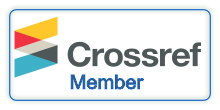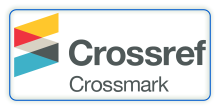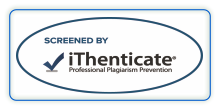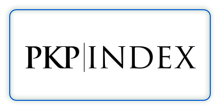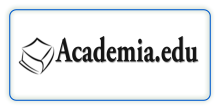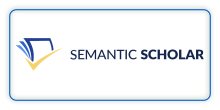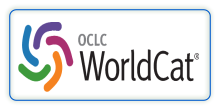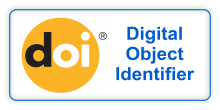VALIDATION OF LEAD (Pb) ANALYSIS METHOD IN FISH MEAL MATRIX BY ELECTROTHERMAL ATOMIC ABSORPTION SPECTROPHOTOMETRY
DOI:
https://doi.org/10.29121/ijoest.v5.i5.2021.215Keywords:
Validation, CRM, Cod Muscle, ETAAS, LeadAbstract
ABSTRACT
Validation of analytical methods is the process of proving that the methods used are scientifically good and suitable for certain purposes. The aim of this study was to validate the analytical method of lead in fish meal matrix by electrothermal atomic absorption spectroscopy (ETAAS) using a phosphate modifier. The research begins with optimization of the analytical conditions that include pyrolysis (ashing) and atomizing temperature, and continues with the validation process by evaluating the analytical performance parameters using a certified reference material (CRM). Method validation was carried out by determining the level of accuracy and precision as well as lead content in a CRM Cod Muscle-422 from BCR. Each experiment was conducted at a wavelength of 283.3 nm, a lamp current of 9.0 amperes, a slit width of 1.3 nm and an argon carrier gas. The optimal pyrolysis and atomizing temperature of lead obtained by adding phosphate modifier was 650 oC and 2000 oC, respectively. The results obtained in this study indicate that the ETAAS lead analysis method using a phosphate modifier is feasible as a test method with an RSD of 3.79%, precision of 0.0043, relative error of 4.0%, accuracy of 104% and recovery of 98% ± 3%. The results of the validation method obtained that the 95% confidence interval for Pb content was 0.088 ± 0.023 µg/g, still within the range of Pb levels in the certificate, namely 0.085 ± 0.015 µg/g of Pb.
Keywords: Validation, CRM, Cod Muscle, ETAAS, Lead
Downloads
References
Bulska, E., and Ruszczyńska, A. (2017). Analytical Techniques for Trace Element Determination, Physical Sciences Reviews, 20178002. DOI: 10.1515/psr-2017-8002. Retrieved from https://doi.org/10.1515/psr-2017-8002
Caulcutt, R., P. Boddy. (1983). Statistics for Analytical Chemistry, Chapman and Hall, London-New York.
Garcia-Alegria, A.M., Gomez-Alvarez, A., Garcia-Rico, L., Serna-Felix, M. (2015). Validation of an Analytical Method to Quantify Serum Electrolytes by Atomic Absorption Spectroscopy. Acta Universitaria, 25(3): 3-12. Retrieved from https://doi.org/10.15174/au.2015.747
Haswell, S.J. (1991). Atomic Absorption Spectrometry, Theory, Design and Applications, Elsiever, Amsterdam.
He Bin & Zhe-Ming Ni. (1996). Minimization of Sulfat Interference on Lead Atomization with Palladium-Strontium Nitrate as Chemical Modifier in Electrothermal Atomic Absorption Spectrometry, J. Anal. At. Spectrom., 11, 165-168. Retrieved from https://doi.org/10.1039/JA9961100165
Master, Z., M., Angelone. C., Brunori. C., Cresmisini. H. Muntau & R. Morabito. (1999). Digestion Methods for Analysis of Fly Ash Samples by Atomic Absorption Spectrometry, Anal. Chim. Acta, 395, 157-163. Retrieved from https://doi.org/10.1016/S0003-2670(99)00342-6
Miller, J.C. & J.N. Miller. (1991). Statistika Untuk Kimia Analitik, ITB, Bandung.
Okamoto, K., K. Fuwa. (1984). Low-Contamination Digestion Bomb Method Using a Teflon Double Vessel for Biological materials, J. Anal. Chem., 56, 1758-1760. Retrieved from https://doi.org/10.1021/ac00273a058
Shirkhanloo, H., Sedighi, K. and Hassan, Z.M. (2014). Determination of Trace Amount of Lead in Industrial and Municipal Effluent Water Samples Based on Dispersive Liquid-Liquid Extraction, J. Mex. Chem. Soc., 58(2): 137-141. Retrieved from https://doi.org/10.29356/jmcs.v58i2.169
Skoog, D.A., D.M. West & F.J. Holler. (1996). Fundamental of Analytical Chemistry, 7th Ed., Saunders College Publishing.
Standar Nasional Indonesia. (2009). Batas Maksiumum Cemaran Logam Berat dalam Pangan. SNI: 7387-2009. Badan Standardisasi Nasional, Jakarta.
Turek, A., Wieczorek, K., and Wolf W.M. (2019). Digestion Procedure and Determination of Heavy Metals in Sewage Sludge-An Analytical Problem, Sustainability, 11: 1753-1763. Retrieved from https://doi.org/10.3390/su11061753
Vinas, P., M. Pardo-Martinez & M. Hermandez-Cordoba. (2000). Rapid Determination of Selenium, Lead and Cadmium in Baby Food Samples Using ETAAS and Slurry Atomization, Anal. Chim. Acta, 412, 121-130. Retrieved from https://doi.org/10.1016/S0003-2670(00)00758-3
Yaman, M., Y. Dilgin & S. Gucer. (2000). Speciation of Lead in Soil and Relation with Its Concentration in Fruits, Anal. Chim. Acta, 410, 119-125. Retrieved from https://doi.org/10.1016/S0003-2670(99)00895-8
Zong, Y.Y., P.J. Parsons & W. Slavin. (1996). Accurate and Precise Measurements of Lead in Bone Using
Zhong Wen-Si, Ren T., and Li-Jao Zhao. (2016). Determination of Pb (Lead), Cd (Cadmium), Cr (Chromium), Cu (Copper), and Ni (Nickel) in Chinese tea with high-resolution continuum source graphite furnace atomic absorption spectrometry, Journal of Food and Drug Analisis, 24: 46-55. Retrieved from https://doi.org/10.1016/j.jfda.2015.04.010












